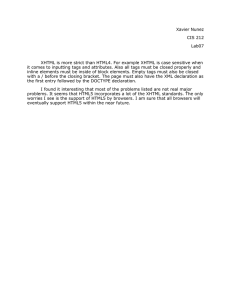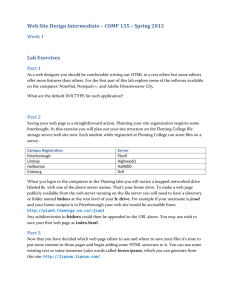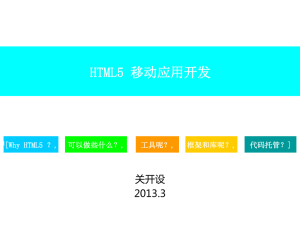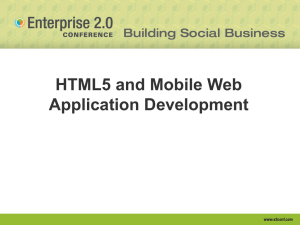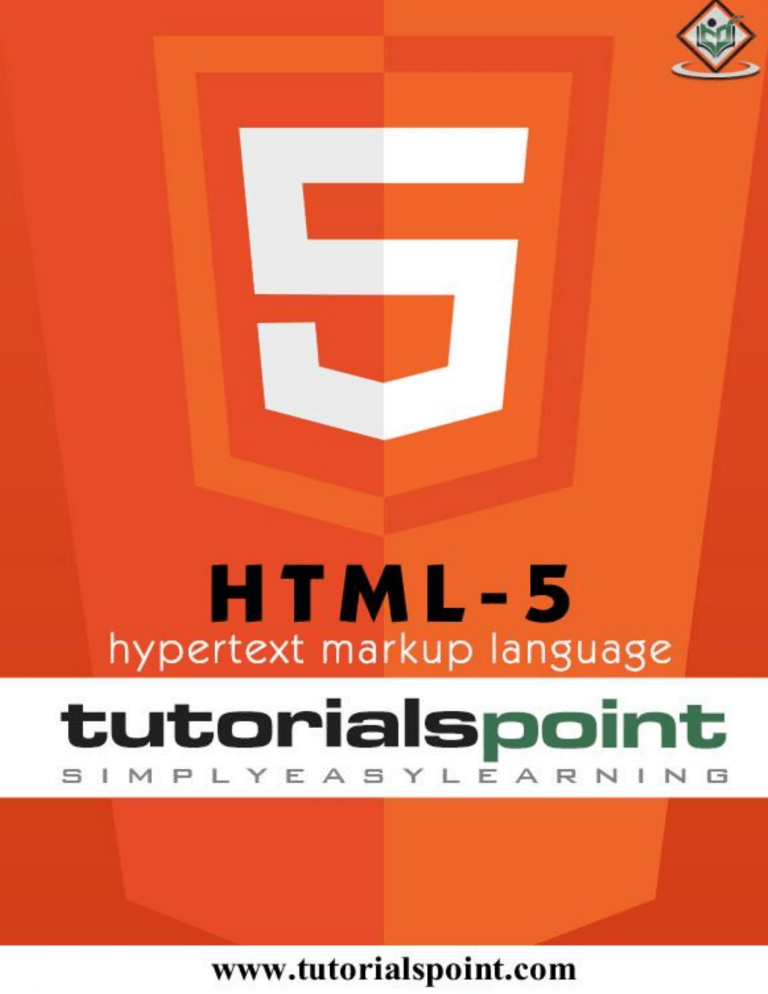
HTML5 HTML5 About the Tutorial HTML5 is the latest and most enhanced version of HTML. Technically, HTML is not a programming language, but rather a markup language. In this tutorial, we will discuss the features of HTML5 and how to use it in practice. Audience This tutorial has been designed for beginners in HTML5 to make them understand the basicto-advanced concepts of the subject. Prerequisites Before starting this tutorial, you should have a basic understanding of HTML and its tags. Disclaimer & Copyright Copyright 2016 by Tutorials Point (I) Pvt. Ltd. All the content and graphics published in this e-book are the property of Tutorials Point (I) Pvt. Ltd. The user of this e-book is prohibited to reuse, retain, copy, distribute, or republish any contents or a part of contents of this e-book in any manner without written consent of the publisher. We strive to update the contents of our website and tutorials as timely and as precisely as possible, however, the contents may contain inaccuracies or errors. Tutorials Point (I) Pvt. Ltd. provides no guarantee regarding the accuracy, timeliness, or completeness of our website or its contents including this tutorial. If you discover any errors on our website or in this tutorial, please notify us at contact@tutorialspoint.com HTML5 Execute HTML5 Online For most of the examples given in this tutorial you will find Try it option, so just make use of this option to execute your HTML5 programs at the spot and enjoy your learning. Try following example using Try it option available at the top right corner of the below sample code box − <!DOCTYPE html> <html> <head> <meta charset="utf-8"> <title>Tutorials Point</title> </head> <body> <header role="banner"> <h1>HTML5 Document Structure Example</h1> <p>This page should be tried in safari, chrome or Mozila.</p> </header> <footer> <p>Created by <a href="http://tutorialspoint.com/">Tutorials Point</a></p> </footer> </body> </html> HTML5 Table of Contents About the Tutorial ................................................................................................................................... 1 Audience ................................................................................................................................................. 1 Prerequisites ........................................................................................................................................... 1 Execute HTML5 Online ............................................................................................................................ 2 Table of Contents .................................................................................................................................... 3 1. HTML5 − OVERVIEW ............................................................................................................ 9 Browser Support ..................................................................................................................................... 9 New Features .......................................................................................................................................... 9 Backward Compatibility ........................................................................................................................ 10 2. HTML5 − SYNTAX ............................................................................................................... 11 The DOCTYPE ........................................................................................................................................ 11 Character Encoding ............................................................................................................................... 11 The <script> tag ..................................................................................................................................... 11 The <link> tag ........................................................................................................................................ 12 HTML5 Elements ................................................................................................................................... 12 HTML5 Attributes .................................................................................................................................. 12 HTML5 Document ................................................................................................................................. 13 3. HTML5 − ATTRIBUTES ........................................................................................................ 16 Standard Attributes............................................................................................................................... 16 Custom Attributes ................................................................................................................................. 17 4. HTML5 − EVENTS ............................................................................................................... 18 5. HTML5 − WEB FORMS 2.0 ................................................................................................. 21 HTML5 The <input> element in HTML4 ............................................................................................................. 21 The <input> element in HTML5 ............................................................................................................. 22 HTML5 - datetime ................................................................................................................................. 23 HTML5 - datetime local ......................................................................................................................... 24 HTML5 – date ........................................................................................................................................ 24 HTML5 – month..................................................................................................................................... 25 HTML5 - week ....................................................................................................................................... 26 HTML5 – time ........................................................................................................................................ 27 HTML5 – number................................................................................................................................... 27 HTML5 – range ...................................................................................................................................... 28 HTML5 - email ....................................................................................................................................... 29 HTML5 – URL ......................................................................................................................................... 30 The <output> element........................................................................................................................... 30 The placeholder attribute...................................................................................................................... 32 The autofocus attribute ........................................................................................................................ 32 The required attribute........................................................................................................................... 33 6. HTML5 − SVG..................................................................................................................... 35 Viewing SVG Files .................................................................................................................................. 35 Embedding SVG in HTML5 ..................................................................................................................... 35 HTML5 − SVG Circle ............................................................................................................................... 36 HTML5 − SVG Rectangle ........................................................................................................................ 36 HTML5 − SVG Line ................................................................................................................................. 37 HTML5 − SVG Ellipse .............................................................................................................................. 38 HTML5 − SVG Polygon ........................................................................................................................... 39 HTML5 − SVG Polyline ........................................................................................................................... 40 HTML5 HTML5 − SVG Gradients ........................................................................................................................ 40 HTML5 − SVG Star ................................................................................................................................. 42 7. HTML5 − MATHML ............................................................................................................ 44 MathML Examples ................................................................................................................................ 44 Using MathML Characters ..................................................................................................................... 45 Matrix Presentation Examples .............................................................................................................. 47 8. HTML5 − WEB STORAGE.................................................................................................... 49 Session Storage ..................................................................................................................................... 49 Local Storage ......................................................................................................................................... 50 Delete Web Storage .............................................................................................................................. 51 9. HTML5 − WEB SQL DATABASE ........................................................................................... 54 The Core Methods ................................................................................................................................. 54 Opening Database ................................................................................................................................. 54 Executing queries .................................................................................................................................. 55 INSERT Operation .................................................................................................................................. 55 READ Operation .................................................................................................................................... 55 Final Example ........................................................................................................................................ 56 10. HTML5 − SERVER SENT EVENTS ......................................................................................... 58 Web Application for SSE ........................................................................................................................ 58 Server Side Script for SSE....................................................................................................................... 59 Handle Server-Sent Events .................................................................................................................... 60 11. HTML5 − WEBSOCKETS ..................................................................................................... 61 WebSocket Attributes ........................................................................................................................... 61 HTML5 WebSocket Events ................................................................................................................................. 62 WebSocket Methods ............................................................................................................................. 62 WebSocket Example .............................................................................................................................. 62 Client Side HTML & JavaScript Code ...................................................................................................... 62 Install pywebsocket .............................................................................................................................. 64 Start the Server ..................................................................................................................................... 64 12. HTML5 − CANVAS .............................................................................................................. 65 The Rendering Context .......................................................................................................................... 66 Browser Support ................................................................................................................................... 66 HTML5 Canvas Examples ....................................................................................................................... 66 HTML5 Canvas - Drawing Rectangles ..................................................................................................... 67 HTML5 Canvas - Drawing Paths ............................................................................................................. 69 HTML5 Canvas - Drawing Lines .............................................................................................................. 72 HTML5 Canvas - Drawing Bezier Curves................................................................................................. 76 HTML5 Canvas - Drawing Quadratic Curves ........................................................................................... 78 HTML5 Canvas - Using Images ............................................................................................................... 81 HTML5 Canvas - Create Gradients ......................................................................................................... 83 HTML5 Canvas - Styles and Colors ......................................................................................................... 88 HTML5 Canvas - Text and Fonts ............................................................................................................. 92 HTML5 Canvas - Pattern and Shadow .................................................................................................... 94 HTML5 Canvas - Save and Restore States .............................................................................................. 98 HTML5 Canvas - Translation ................................................................................................................ 101 HTML5 Canvas - Rotation .................................................................................................................... 104 HTML5 Canvas - Scaling ....................................................................................................................... 106 HTML5 Canvas - Transforms ................................................................................................................ 109 HTML5 HTML5 Canvas - Composition .............................................................................................................. 112 HTML5 Canvas - Animations ................................................................................................................ 116 13. HTML5 − AUDIO & VIDEO ................................................................................................ 119 Embedding Video ................................................................................................................................ 119 Video Attribute Specification .............................................................................................................. 120 Embedding Audio ................................................................................................................................ 121 Audio Attribute Specification .............................................................................................................. 122 Handling Media Events........................................................................................................................ 122 Configuring Servers for Media Type .................................................................................................... 124 14. HTML5 − GEOLOCATION.................................................................................................. 125 Geolocation Methods.......................................................................................................................... 125 Geolocation getCurrentPosition() API ................................................................................................. 126 Geolocation watchPosition() API ......................................................................................................... 128 Geolocation clearWatch() API ............................................................................................................. 130 Location Properties ............................................................................................................................. 132 Handling Errors ................................................................................................................................... 133 Position Options .................................................................................................................................. 134 15. HTML5 − MICRODATA ..................................................................................................... 136 Example .............................................................................................................................................. 136 Global Attributes ................................................................................................................................. 137 Properties Datatypes........................................................................................................................... 137 Microdata API support ........................................................................................................................ 138 Defining Microdata Vocabulary ........................................................................................................... 138 16. HTML5 − DRAG & DROP .................................................................................................. 140 HTML5 Drag and Drop Events .......................................................................................................................... 140 The DataTransfer Object: .................................................................................................................... 141 Drag and Drop Process ........................................................................................................................ 142 17. HTML5 − WEB WORKERS ................................................................................................. 146 What is Web Workers?........................................................................................................................ 147 How Web Workers Work? ................................................................................................................... 148 Stopping Web Workers ....................................................................................................................... 149 Handling Errors ................................................................................................................................... 149 Checking for Browser Support ............................................................................................................. 150 18. HTML5 – INDEXEDDB ...................................................................................................... 152 19. HTML5 − WEB MESSAGING ............................................................................................. 160 20. HTML5 − CORS ................................................................................................................ 163 21. HTML5 − WEB RTC........................................................................................................... 167 1. HTML5 − OVERVIEW HTML5 HTML5 is the next major revision of the HTML standard superseding HTML 4.01, XHTML 1.0, and XHTML 1.1. HTML5 is a standard for structuring and presenting content on the World Wide Web. HTML5 is a cooperation between the World Wide Web Consortium (W3C) and the Web Hypertext Application Technology Working Group (WHATWG). The new standard incorporates features like video playback and drag-and-drop that have been previously dependent on third-party browser plug-ins such as Adobe Flash, Microsoft Silverlight, and Google Gears. Browser Support The latest versions of Apple Safari, Google Chrome, Mozilla Firefox, and Opera all support many HTML5 features and Internet Explorer 9.0 will also have support for some HTML5 functionality. The mobile web browsers that come pre-installed on iPhones, iPads, and Android phones all have excellent support for HTML5. New Features HTML5 introduces a number of new elements and attributes that can help you in building modern websites. Here is a set of some of the most prominent features introduced in HTML5. New Semantic Elements: These are like <header>, <footer>, and <section>. Forms 2.0: Improvements to HTML web forms where new attributes have been introduced for <input> tag. Persistent Local Storage: To achieve without resorting to third-party plugins. WebSocket : A next-generation bidirectional communication technology for web applications. Server-Sent Events: HTML5 introduces events which flow from web server to the web browsers and they are called Server-Sent Events (SSE). Canvas: This supports a two-dimensional drawing surface that you can program with JavaScript. Audio & Video: You can embed audio or video on your webpages without resorting to third-party plugins. HTML5 Geolocation: Now visitors can choose to share their physical location with your web application. Microdata: This lets you create your own vocabularies beyond HTML5 and extend your web pages with custom semantics. Drag and drop: Drag and drop the items from one location to another location on the same webpage. Backward Compatibility HTML5 is designed, as much as possible, to be backward compatible with existing web browsers. Its new features have been built on existing features and allow you to provide fallback content for older browsers. It is suggested to detect support for individual HTML5 features using a few lines of JavaScript. If you are not familiar with any previous version of HTML, I would recommend that you go through our HTML Tutorial before exploring the features of HTML5. 2. HTML5 − SYNTAX HTML5 The HTML 5 language has a "custom" HTML syntax that is compatible with HTML 4 and XHTML1 documents published on the Web, but is not compatible with the more esoteric SGML features of HTML 4. HTML 5 does not have the same syntax rules as XHTML where we needed lower case tag names, quoting our attributes, an attribute had to have a value and to close all empty elements. HTML5 comes with a lot of flexibility and it supports the following features − Uppercase tag names. Quotes are optional for attributes. Attribute values are optional. Closing empty elements are optional. The DOCTYPE DOCTYPEs in older versions of HTML were longer because the HTML language was SGML based and therefore required a reference to a DTD. HTML 5 authors would use simple syntax to specify DOCTYPE as follows: <!DOCTYPE html> The above syntax is case-insensitive. Character Encoding HTML 5 authors can use simple syntax to specify Character Encoding as follows − <meta charset="UTF-8"> The above syntax is case-insensitive. The <script> tag It's common practice to add a type attribute with a value of "text/javascript" to script elements as follows − <script type="text/javascript" src="scriptfile.js"></script> HTML5 HTML 5 removes extra information required and you can use simply following syntax − <script src="scriptfile.js"></script> The <link> tag So far you were writing <link> as follows − <link rel="stylesheet" type="text/css" href="stylefile.css"> HTML 5 removes extra information required and you can simply use the following syntax − <link rel="stylesheet" href="stylefile.css"> HTML5 Elements HTML5 elements are marked up using start tags and end tags. Tags are delimited using angle brackets with the tag name in between. The difference between start tags and end tags is that the latter includes a slash before the tag name. Following is the example of an HTML5 element − <p>...</p> HTML5 tag names are case insensitive and may be written in all uppercase or mixed case, although the most common convention is to stick with lowercase. Most of the elements contain some content like <p>...</p> contains a paragraph. Some elements, however, are forbidden from containing any content at all and these are known as void elements. For example, br, hr, link, meta, etc. Here is a complete list of HTML5 Elements. HTML5 Attributes Elements may contain attributes that are used to set various properties of an element. Some attributes are defined globally and can be used on any element, while others are defined for specific elements only. All attributes have a name and a value and look like as shown below in the example. Following is the example of an HTML5 attribute which illustrates how to mark up a div element with an attribute named class using a value of "example" − <div class="example">...</div> Attributes may only be specified within start tags and must never be used in end tags. HTML5 HTML5 attributes are case insensitive and may be written in all uppercase or mixed case, although the most common convention is to stick with lowercase. Here is a complete list of HTML5 Attributes. HTML5 Document The following tags have been introduced for better structure − section: This tag represents a generic document or application section. It can be used together with h1-h6 to indicate the document structure. article: This tag represents an independent piece of content of a document, such as a blog entry or newspaper article. aside: This tag represents a piece of content that is only slightly related to the rest of the page. header: This tag represents the header of a section. footer: This tag represents a footer for a section and can contain information about the author, copyright information, et cetera. nav: This tag represents a section of the document intended for navigation. dialog: This tag can be used to mark up a conversation. figure: This tag can be used to associate a caption together with some embedded content, such as a graphic or video. The markup for an HTML 5 document would look like the following − <!DOCTYPE html> <html> <head> <meta charset="utf-8"> <title>...</title> </head> <body> <header>...</header> <nav>...</nav> <article> HTML5 <section> ... </section> </article> <aside>...</aside> <footer>...</footer> </body> </html> <!DOCTYPE html> <html> <head> <meta charset="utf-8"> <title>...</title> </head> <body> <header role="banner"> <h1>HTML5 Document Structure Example</h1> <p>This page should be tried in safari, chrome or Mozila.</p> </header> <nav> <ul> <li><a href="http://www.tutorialspoint.com/html">HTML Tutorial</a></li> <li><a href="http://www.tutorialspoint.com/css">CSS Tutorial</a></li> <li><a href="http://www.tutorialspoint.com/javascript">JavaScript Tutorial</a></li> </ul> HTML5 </nav> <article> <section> <p>Once article can have multiple sections</p> </section> </article> <aside> <p>This is aside part of the web page</p> </aside> <footer> <p>Created by <a href="http://tutorialspoint.com/">Tutorials Point</a></p> </footer> </body> </html> It will produce the following result – HTML5 3. HTML5 − ATTRIBUTES HTML5 As explained in the previous chapter, elements may contain attributes that are used to set various properties of an element. Some attributes are defined globally and can be used on any element, while others are defined for specific elements only. All attributes have a name and a value and look like as shown below in the example. Following is the example of an HTML5 attributes which illustrates how to mark up a div element with an attribute named class using a value of "example" − <div class="example">...</div> Attributes may only be specified within start tags and must never be used in end tags. HTML5 attributes are case insensitive and may be written in all uppercase or mixed case, although the most common convention is to stick with lowercase. Standard Attributes The attributes listed below are supported by almost all the HTML 5 tags. Attribute Options accesskey User Defined align background right, left, center URL numeric, hexidecimal, RGB values bgcolor class User Defined contenteditable true, false contextmenu Menu id data-XXXX User Defined draggable true,false, auto height Numeric Value hidden hidden Function Specifies a keyboard shortcut to access an element. Horizontally aligns tags Places an background image behind an element Places a background color behind an element Classifies an element for use with Cascading Style Sheets. Specifies if the user can edit the element's content or not. Specifies the context menu for an element. Custom attributes. Authors of a HTML document can define their own attributes. Must start with "data-". Specifies whether or not a user is allowed to drag an element. Specifies the height of tables, images, or table cells. Specifies whether element should be visible or not. HTML5 id User Defined item itemprop List of elements List of items spellcheck true, false style subject tabindex title valign CSS Style sheet User define id Tab number User Defined top, middle, bottom width Numeric Value Names an element for use with Cascading Style Sheets. Used to group elements. Used to group items. Specifies if the element must have it's spelling or grammar checked. Specifies an inline style for an element. Specifies the element's corresponding item. Specifies the tab order of an element. "Pop-up" title for your elements. Vertically aligns tags within an HTML element. Specifies the width of tables, images, or table cells. For a complete list of HTML5 Tags and related attributes, please check our reference to HTML5 Tags. Custom Attributes A new feature being introduced in HTML 5 is the addition of custom data attributes. A custom data attribute starts with data- and would be named based on your requirement. Here is a simple example – <div class="example" data-subject="physics" data-level="complex"> ... </div> The above code will be perfectly valid HTML5 with two custom attributes called datasubject and data-level. You would be able to get the values of these attributes using JavaScript APIs or CSS in similar way as you get for standard attributes. 4. HTML5 − EVENTS HTML5 When users visit your website, they perform various activities such as clicking on text and images and links, hover over defined elements, etc. These are examples of what JavaScript calls events. We can write our event handlers in Javascript or VBscript and you can specify these event handlers as a value of event tag attribute. The HTML5 specification defines various event attributes as listed below − We can use the following set of attributes to trigger any javascript or vbscript code given as value, when there is any event that takes place for any HTML5 element. We would cover element-specific events while discussing those elements in detail in subsequent chapters. Attribute offline onabort onafterprint onbeforeonload onbeforeprint onblur Value script script script script script script oncanplay script oncanplaythrough script onchange onclick oncontextmenu ondblclick ondrag ondragend script script script script script script ondragenter script ondragleave script ondragover script ondragstart ondrop ondurationchange script script script onemptied script onended onerror onfocus onformchange script script script script Description Triggers when the document goes offline Triggers on an abort event Triggers after the document is printed Triggers before the document loads Triggers before the document is printed Triggers when the window loses focus Triggers when media can start play, but might has to stop for buffering Triggers when media can be played to the end, without stopping for buffering Triggers when an element changes Triggers on a mouse click Triggers when a context menu is triggered Triggers on a mouse double-click Triggers when an element is dragged Triggers at the end of a drag operation Triggers when an element has been dragged to a valid drop target Triggers when an element leaves a valid drop target Triggers when an element is being dragged over a valid drop target Triggers at the start of a drag operation Triggers when dragged element is being dropped Triggers when the length of the media is changed Triggers when a media resource element suddenly becomes empty. Triggers when media has reach the end Triggers when an error occur Triggers when the window gets focus Triggers when a form changes HTML5 onforminput onhaschange oninput oninvalid onkeydown onkeypress onkeyup onload onloadeddata script script script script script script script script script onloadedmetadata script onloadstart onmessage onmousedown onmousemove onmouseout onmouseover onmouseup onmousewheel onoffline onoine ononline onpagehide onpageshow onpause onplay onplaying onpopstate onprogress onratechange onreadystatechange onredo onresize onscroll script script script script script script script script script script script script script script script script script script script script script script script onseeked script onseeking script onselect onstalled onstorage onsubmit script script script script onsuspend script ontimeupdate onundo onunload script script script onvolumechange script Triggers when a form gets user input Triggers when the document has change Triggers when an element gets user input Triggers when an element is invalid Triggers when a key is pressed Triggers when a key is pressed and released Triggers when a key is released Triggers when the document loads Triggers when media data is loaded Triggers when the duration and other media data of a media element is loaded Triggers when the browser starts to load the media data Triggers when the message is triggered Triggers when a mouse button is pressed Triggers when the mouse pointer moves Triggers when the mouse pointer moves out of an element Triggers when the mouse pointer moves over an element Triggers when a mouse button is released Triggers when the mouse wheel is being rotated Triggers when the document goes offline Triggers when the document comes online Triggers when the document comes online Triggers when the window is hidden Triggers when the window becomes visible Triggers when media data is paused Triggers when media data is going to start playing Triggers when media data has start playing Triggers when the window's history changes Triggers when the browser is fetching the media data Triggers when the media data's playing rate has changed Triggers when the ready-state changes Triggers when the document performs a redo Triggers when the window is resized Triggers when an element's scrollbar is being scrolled Triggers when a media element's seeking attribute is no longer true, and the seeking has ended Triggers when a media element's seeking attribute is true, and the seeking has begun Triggers when an element is selected Triggers when there is an error in fetching media data Triggers when a document loads Triggers when a form is submitted Triggers when the browser has been fetching media data, but stopped before the entire media file was fetched Triggers when media changes its playing position Triggers when a document performs an undo Triggers when the user leaves the document Triggers when media changes the volume, also when volume is set to "mute" HTML5 onwaiting script Triggers when media has stopped playing, but is expected to resume 5. HTML5 − WEB FORMS 2.0 HTML5 Web Forms 2.0 is an extension to the forms features found in HTML4. Form elements and attributes in HTML5 provide a greater degree of semantic mark-up than HTML4 and free us from a great deal of tedious scripting and styling that was required in HTML4. The <input> element in HTML4 HTML4 input elements use the type attribute to specify the data type.HTML4 provides following types − Type text password checkbox radio submit file image hidden select textarea button Description A free-form text field, nominally free of line breaks. A free-form text field for sensitive information, nominally free of line breaks. A set of zero or more values from a predefined list. An enumerated value. A free form of button initiates form submission. An arbitrary file with a MIME type and optionally a file name. A coordinate, relative to a particular image's size, with the extra semantic that it must be the last value selected and initiates form submission. An arbitrary string that is not normally displayed to the user. An enumerated value, much like the radio type. A free-form text field, nominally with no line break restrictions. A free form of button which can initiates any event related to button. Following is the simple example of using labels, radio buttons, and submit buttons − ... <form action="http://example.com/cgiscript.pl" method="post"> <p> <label for="firstname">first name: </label> <input type="text" id="firstname"><br /> <label for="lastname">last name: </label> <input type="text" id="lastname"><br /> <label for="email">email: </label> <input type="text" id="email"><br> HTML5 <input type="radio" name="sex" value="male"> Male<br> <input type="radio" name="sex" value="female"> Female<br> <input type="submit" value="send"> <input type="reset"> </p> </form> ... The <input> element in HTML5 Apart from the above-mentioned attributes, HTML5 input elements introduced several new values for the type attribute. These are listed below. NOTE: Try all the following example using latest version of Opera browser. Type datetime datetimelocal date month week time number range email url Description A date and time (year, month, day, hour, minute, second, fractions of a second) encoded according to ISO 8601 with the time zone set to UTC. A date and time (year, month, day, hour, minute, second, fractions of a second) encoded according to ISO 8601, with no time zone information. A date (year, month, day) encoded according to ISO 8601. A date consisting of a year and a month encoded according to ISO 8601. A date consisting of a year and a week number encoded according to ISO 8601. A time (hour, minute, seconds, fractional seconds) encoded according to ISO 8601. It accepts only numerical value. The step attribute specifies the precision, defaulting to 1. The range type is used for input fields that should contain a value from a range of numbers. It accepts only email value. This type is used for input fields that should contain an e-mail address. If you try to submit a simple text, it forces to enter only email address in email@example.com format. It accepts only URL value. This type is used for input fields that should contain a URL address. If you try to submit a simple text, it forces to enter only URL address either in http://www.example.com format or in http://example.com format. HTML5 - datetime A date and time (year, month, day, hour, minute, second, fractions of a second) encoded according to ISO 8601 with the time zone set to UTC. Example <!DOCTYPE HTML> HTML5 <html> <body> <form action = "/cgi-bin/html5.cgi" method = "get"> Date and Time : <input type = "datetime" name = "newinput" /> <input type = "submit" value = "submit" /> </form> </body> </html> Output HTML5 End of ebook preview If you liked what you saw… Buy it from our store @ https://store.tutorialspoint.com
